1997 TOYOTA TACOMA ECU
[x] Cancel search: ECUPage 13 of 221
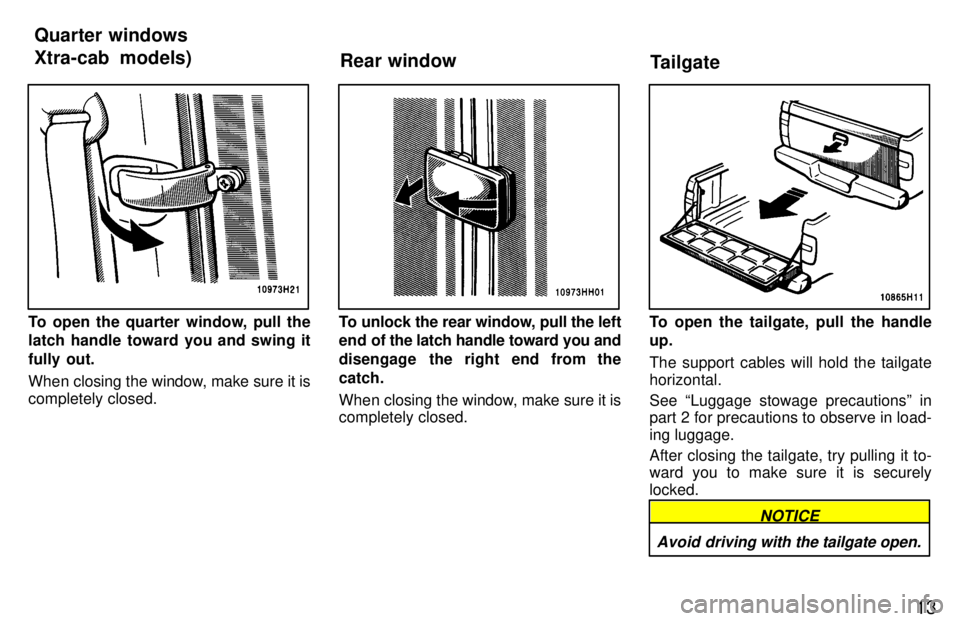
13
To open the quarter window, pull the
latch handle toward you and swing it
fully out.
When closing the window, make sure it is completely closed.To unlock the rear window, pull the left
end of the latch handle toward you and
disengage the right end from thecatch.
When closing the window, make sure it is completely closed.To open the tailgate, pull the handle up.
The support cables will hold the tailgate horizontal. See Luggage stowage precautionsº in
part 2 for precautions to observe in load- ing luggage.
After closing the tailgate, try pulling it to-
ward you to make sure it is securely locked.
Avoid driving with the tailgate open.
NOTICE
Tailgate
Quarter windows Xtra-cab models)
Rear window
Page 14 of 221
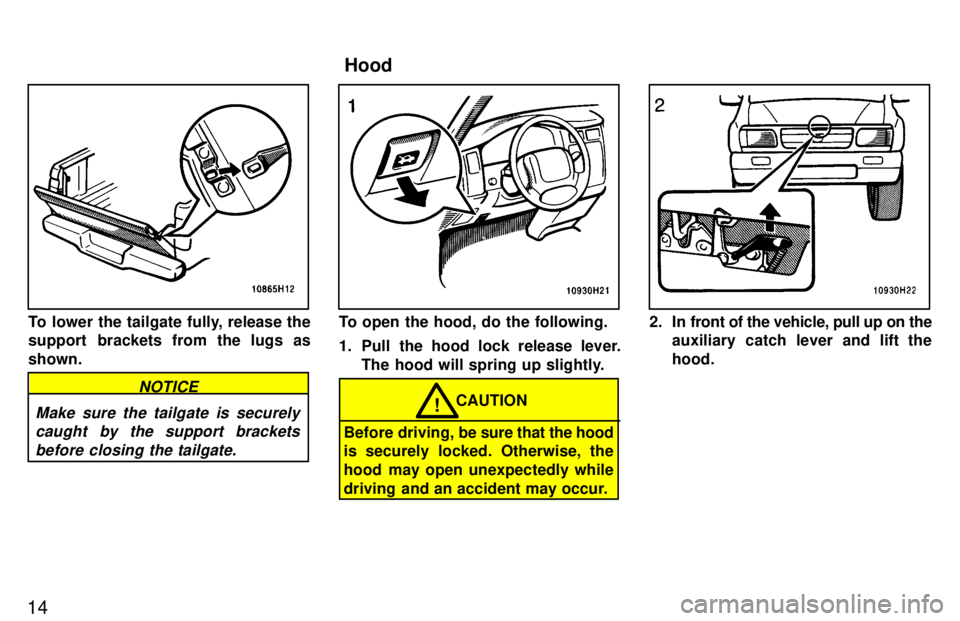
14
To lower the tailgate fully, release the
support brackets from the lugs as shown.
Make sure the tailgate is securelycaught by the support brackets
before closing the tailgate.
NOTICE
To open the hood, do the following.
1. Pull the hood lock release lever. The hood will spring up slightly.
Before driving, be sure that the hood
is securely locked. Otherwise, the
hood may open unexpectedly while
driving and an accident may occur.
CAUTION!
2. In front of the vehicle, pull up on the auxiliary catch lever and lift the hood.
Hood
Page 15 of 221
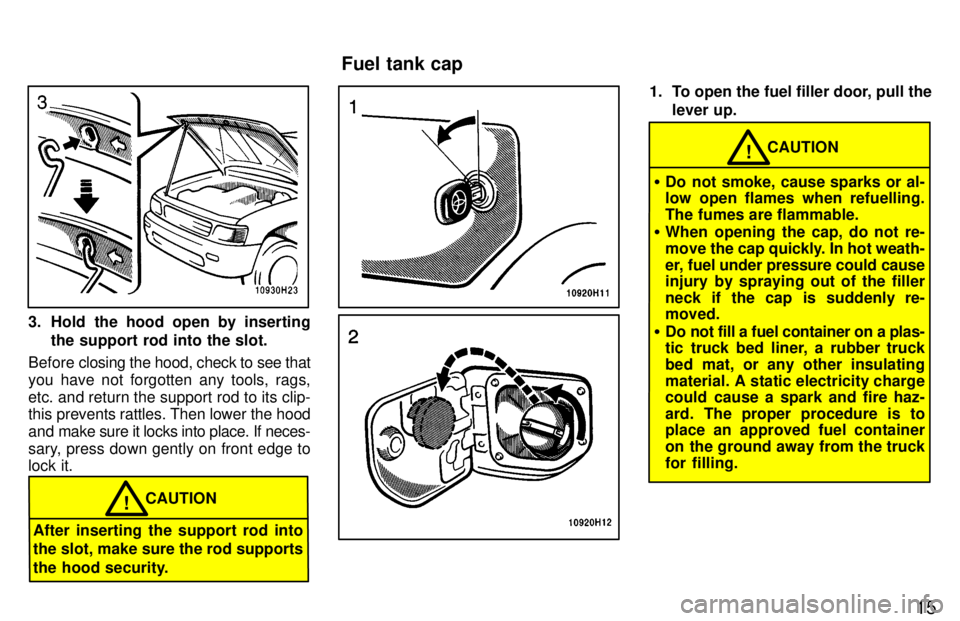
15
3. Hold the hood open by insertingthe support rod into the slot.
Before closing the hood, check to see that
you have not forgotten any tools, rags,
etc. and return the support rod to its clip-
this prevents rattles. Then lower the hood
and make sure it locks into place. If neces-
sary, press down gently on front edge to lock it.
After inserting the support rod into
the slot, make sure the rod supports
the hood security.
CAUTION!
1. To open the fuel filler door, pull the
lever up.
CAUTION!
� Do not smoke, cause sparks or al-
low open flames when refuelling.
The fumes are flammable.
� When opening the cap, do not re-
move the cap quickly. In hot weath-
er, fuel under pressure could cause
injury by spraying out of the filler
neck if the cap is suddenly re- moved.
� Do not fill a fuel container on a plas-
tic truck bed liner, a rubber truck
bed mat, or any other insulating
material. A static electricity charge
could cause a spark and fire haz-
ard. The proper procedure is to
place an approved fuel container
on the ground away from the truckfor filling.
Fuel tank cap
Page 16 of 221
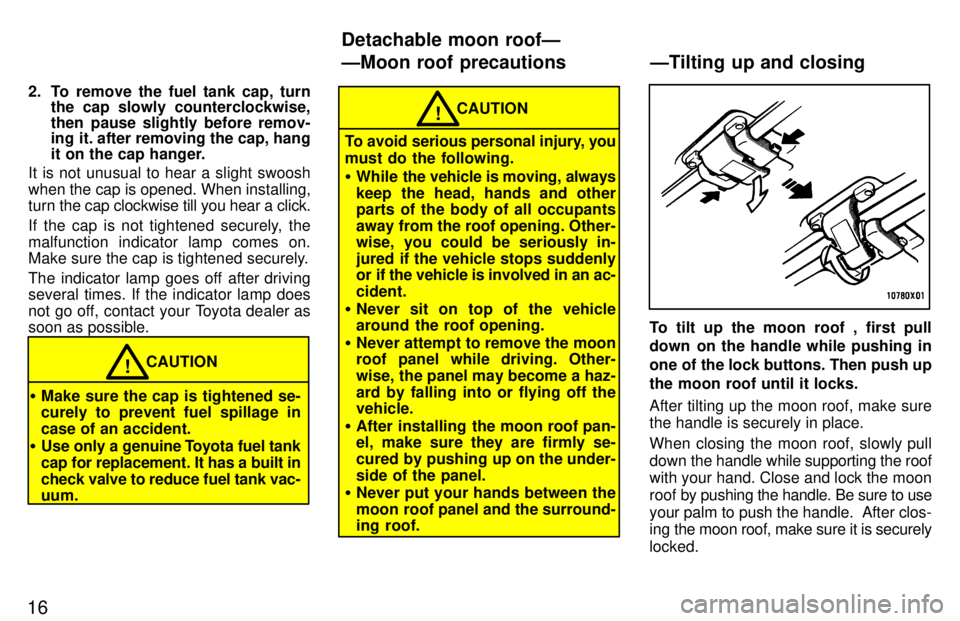
162. To remove the fuel tank cap, turn
the cap slowly counterclockwise,
then pause slightly before remov-
ing it. after removing the cap, hang
it on the cap hanger.
It is not unusual to hear a slight swoosh
when the cap is opened. When installing,
turn the cap clockwise till you hear a click.
If the cap is not tightened securely, the malfunction indicator lamp comes on.
Make sure the cap is tightened securely.
The indicator lamp goes off after driving several times. If the indicator lamp does
not go off, contact your Toyota dealer as soon as possible.
CAUTION!
� Make sure the cap is tightened se-
curely to prevent fuel spillage in
case of an accident.
� Use only a genuine Toyota fuel tankcap for replacement. It has a built incheck valve to reduce fuel tank vac- uum.
CAUTION!
To avoid serious personal injury, you
must do the following. � While the vehicle is moving, always
keep the head, hands and other
parts of the body of all occupants away from the roof opening. Other-
wise, you could be seriously in-
jured if the vehicle stops suddenly
or if the vehicle is involved in an ac- cident.
� Never sit on top of the vehicle
around the roof opening.
� Never attempt to remove the moon
roof panel while driving. Other-
wise, the panel may become a haz-ard by falling into or flying off the vehicle.
� After installing the moon roof pan-
el, make sure they are firmly se-
cured by pushing up on the under-
side of the panel.
� Never put your hands between the
moon roof panel and the surround-
ing roof.
To tilt up the moon roof , first pull
down on the handle while pushing in
one of the lock buttons. Then push up
the moon roof until it locks. After tilting up the moon roof, make sure the handle is securely in place.
When closing the moon roof, slowly pull
down the handle while supporting the roof
with your hand. Close and lock the moon
roof by pushing the handle. Be sure to use
your palm to push the handle. After clos-
ing the moon roof, make sure it is securely locked. ÐTilting up and closing
Detachable moon roofÐ ÐMoon roof precautions
Page 21 of 221
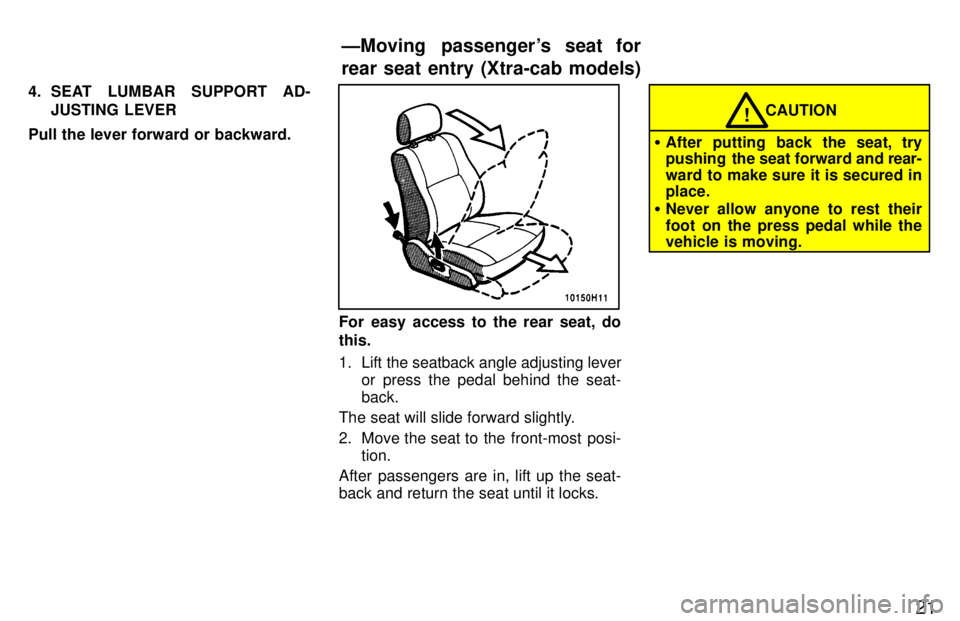
21
4. SEAT LUMBAR SUPPORT AD-
JUSTING LEVER
Pull the lever forward or backward.
For easy access to the rear seat, do this.
1. Lift the seatback angle adjusting lever or press the pedal behind the seat- back.
The seat will slide forward slightly.
2. Move the seat to the front-most posi- tion.
After passengers are in, lift up the seat- back and return the seat until it locks.
CAUTION!
� After putting back the seat, try
pushing the seat forward and rear-
ward to make sure it is secured inplace.
� Never allow anyone to rest their
foot on the press pedal while the
vehicle is moving.
ÐMoving passenger's seat for
rear seat entry (Xtra-cab models)
Page 22 of 221
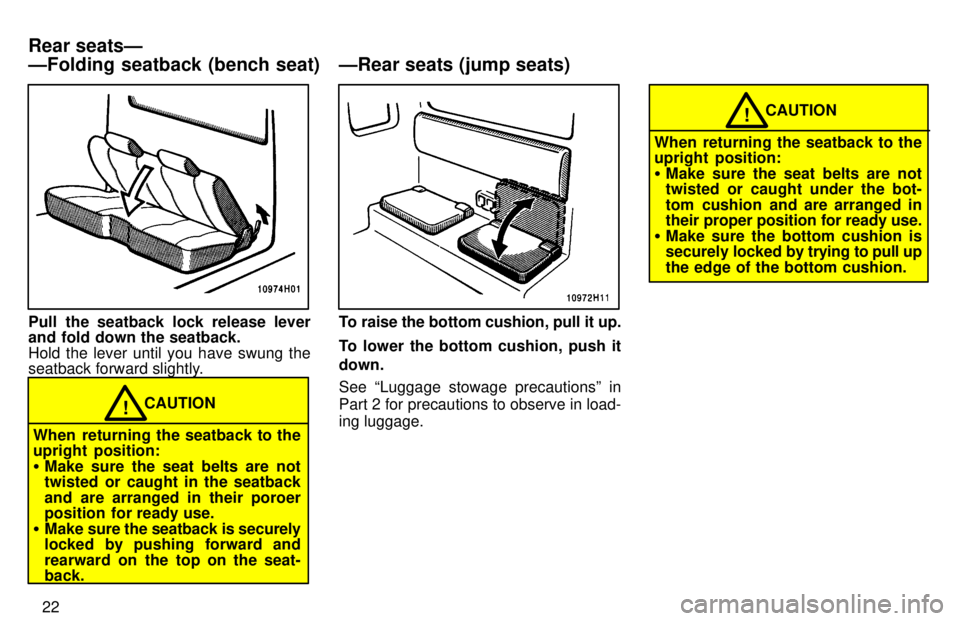
22
Pull the seatback lock release lever
and fold down the seatback.
Hold the lever until you have swung the
seatback forward slightly.
CAUTION!
When returning the seatback to the
upright position: � Make sure the seat belts are not
twisted or caught in the seatback
and are arranged in their poroer
position for ready use.
� Make sure the seatback is securely
locked by pushing forward and
rearward on the top on the seat- back.
To raise the bottom cushion, pull it up.
To lower the bottom cushion, push it down. See Luggage stowage precautionsº in
Part 2 for precautions to observe in load- ing luggage.
CAUTION!
When returning the seatback to the
upright position: � Make sure the seat belts are not twisted or caught under the bot-
tom cushion and are arranged in
their proper position for ready use.
� Make sure the bottom cushion is
securely locked by trying to pull up
the edge of the bottom cushion.
Rear seatsÐ
ÐFolding seatback (bench seat) ÐRear seats (jump seats)
Page 24 of 221
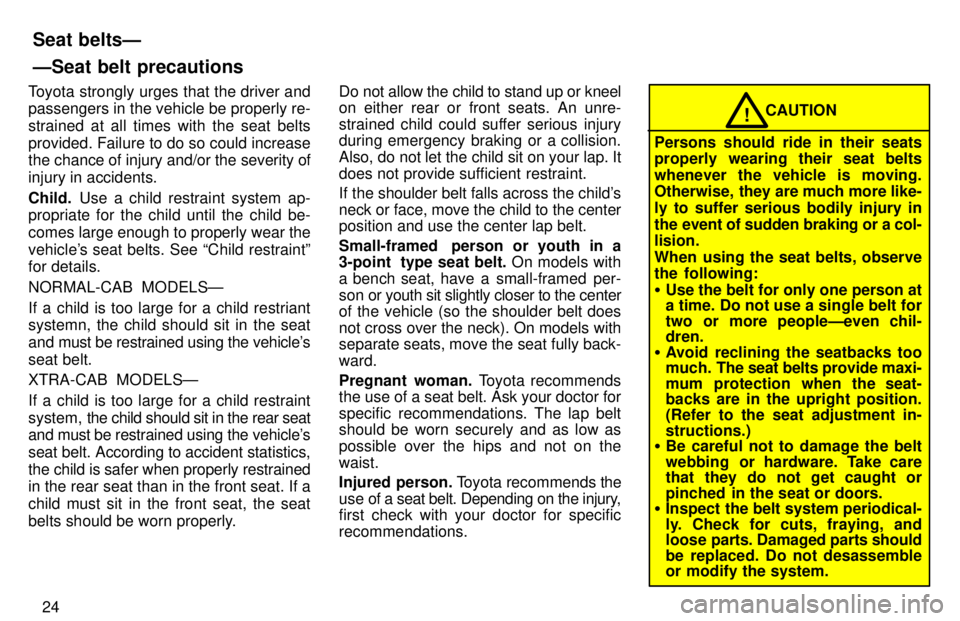
24
Toyota strongly urges that the driver and passengers in the vehicle be properly re- strained at all times with the seat belts
provided. Failure to do so could increase
the chance of injury and/or the severity of
injury in accidents. Child.
Use a child restraint system ap-
propriate for the child until the child be-
comes large enough to properly wear the
vehicle's seat belts. See Child restraintº
for details. NORMAL-CAB MODELSÐ
If a child is too large for a child restriant
systemn, the child should sit in the seat
and must be restrained using the vehicle's
seat belt. XTRA-CAB MODELSÐ
If a child is too large for a child restraint
system, the child should sit in the rear seat
and must be restrained using the vehicle's
seat belt. According to accident statistics,the child is safer when properly restrained
in the rear seat than in the front seat. If a
child must sit in the front seat, the seat
belts should be worn properly. Do not allow the child to stand up or kneel
on either rear or front seats. An unre-
strained child could suffer serious injury
during emergency braking or a collision.
Also, do not let the child sit on your lap. It
does not provide sufficient restraint.
If the shoulder belt falls across the child's neck or face, move the child to the center
position and use the center lap belt.
Small-framed person or youth in a
3-point type seat belt.
On models with
a bench seat, have a small-framed per-
son or youth sit slightly closer to the center
of the vehicle (so the shoulder belt does
not cross over the neck). On models with separate seats, move the seat fully back- ward.
Pregnant woman. Toyota recommends
the use of a seat belt. Ask your doctor for
specific recommendations. The lap belt
should be worn securely and as low as
possible over the hips and not on thewaist.
Injured person. Toyota recommends the
use of a seat belt. Depending on the injury,
first check with your doctor for specific recommendations.
CAUTION!
Persons should ride in their seats
properly wearing their seat belts whenever the vehicle is moving.
Otherwise, they are much more like-
ly to suffer serious bodily injury in
the event of sudden braking or a col- lision.
When using the seat belts, observe
the following: � Use the belt for only one person at
a time. Do not use a single belt for
two or more peopleÐeven chil- dren.
� Avoid reclining the seatbacks too
much. The seat belts provide maxi-
mum protection when the seat-backs are in the upright position.
(Refer to the seat adjustment in-structions.)
� Be careful not to damage the belt
webbing or hardware. Take care
that they do not get caught or
pinched in the seat or doors.
� Inspect the belt system periodical-
ly. Check for cuts, fraying, and
loose parts. Damaged parts should
be replaced. Do not desassemble
or modify the system.
Seat beltsÐ ÐSeat belt precautions
Page 26 of 221
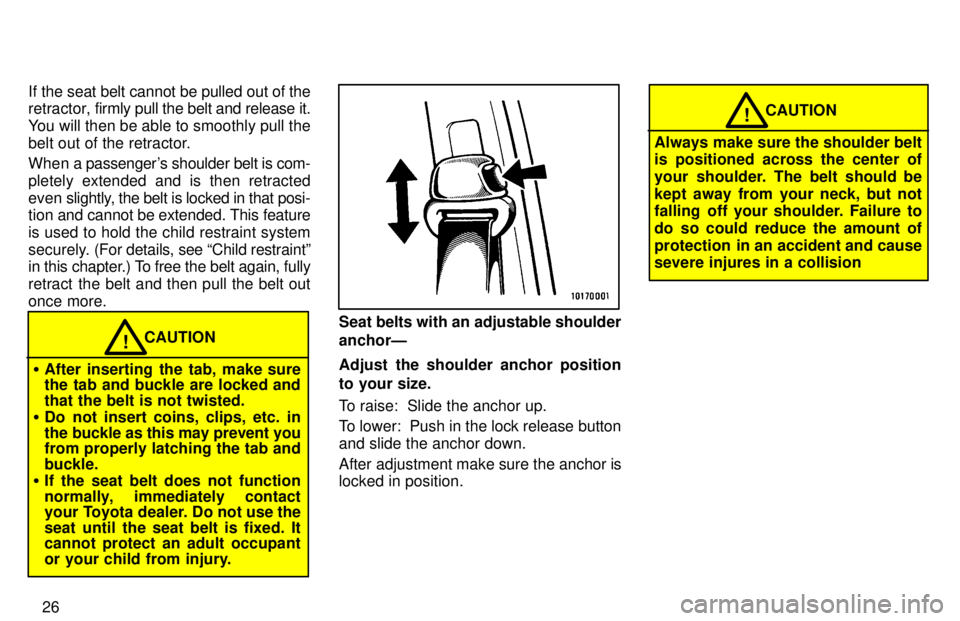
26
If the seat belt cannot be pulled out of the
retractor,
firmly pull the belt and release it.
You will then be able to smoothly pull the
belt out of the retractor.
When a passenger's shoulder belt is com-
pletely extended and is then retracted
even slightly, the belt is locked in that posi-
tion and cannot be extended. This feature
is used to hold the child restraint system
securely. (For details, see Child restraintº
in this chapter.) To free the belt again, fully
retract the belt and then pull the belt out
once more.
CAUTION!
� After inserting the tab, make sure
the tab and buckle are locked and that the belt is not twisted.
� Do not insert coins, clips, etc. in
the buckle as this may prevent you
from properly latching the tab and buckle.
� If the seat belt does not function
normally, immediately contact
your Toyota dealer. Do not use the
seat until the seat belt is fixed. It cannot protect an adult occupant
or your child from injury.
Seat belts with an adjustable shoulder anchorÐ
Adjust the shoulder anchor position
to your size.
To raise: Slide the anchor up.
To lower: Push in the lock release button
and slide the anchor down.
After adjustment make sure the anchor is
locked in position.
CAUTION!
Always make sure the shoulder belt
is positioned across the center of
your shoulder. The belt should be
kept away from your neck, but not
falling off your shoulder. Failure to
do so could reduce the amount of
protection in an accident and cause severe injures in a collision